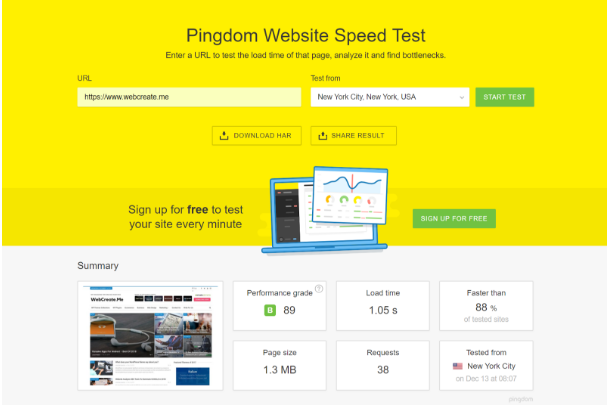AMP, which stands for Accelerated Mobile Pages, is a project created by Google in order to make the web or the increasing amount of mobile users. It is basically an online publishing format optimized for mobile devices that is supposed to ensure rapid loading times, especially when visiting a website from Google search results.

In this article, Viktor Viktor from WebCreate.Me, will try to explain what AMP is, how it works and why you should really consider implementing it to your website.
What is AMP and how it works
AMP’s main principle is to provide mobile internet users with a great user experience (UX). But how does it do it?
AMP consists of 3 core components that work together to create this great UX:
AMP HTML
AMP JS
AMP Cache
When web designers and owners use these components to build websites, their visitors will benefit from the great benefits of AMP. However, AMP’s core components put some restraints on web designers because it limits their ability to use different and more complex tools to create their websites.
1. AMP HTML
AMP HTML is very similar to the regular version of HTML. It just has some restrictions and custom properties that are implemented to ensure website’s reliable performance and max it’s mobile-friendliness.
One custom element worth mentioning is <amp-img>. It has full scrset support for the use of responsive images. And what’s more, this functionality works even in browsers that don’t natively support srcset just yet.
2. AMP JS
AMP JS is a custom JavaScript (JS) library that ensures fast rendering of AMP websites. It contains everything you need to create a fast AMP website. To keep JS from blocking or delaying the rendering of websites, AMP only allows asynchronous JS loading.
You can also use external JS, however, they must be put into sandboxed iframes. Thanks to this practice, external JS cannot block the rendering and execution of the main and most important parts of your website. This is useful for example for displaying ads on your website.
3. AMP Cache
You probably already know that caching can improve your website’s performance. AMP loads cached resources directly from Google AMP Cache to provide fast loading and great UX. Your website will load really quickly, especially when being accessed from the Google result page.
The cache also comes with a built-in validation system that makes sure your website works and is not dependent on external sources.
Advantages of AMP
If you run a website with a considerable portion of visitors using mobile devices, you will most likely benefit from the advantages of AMP.
AMP is not perfect. However, it does bring some huge benefits to the website owners that decided to implement it. I will try to mention the AMP benefits that I find most important.
Lightning fast website loading
The most striking benefit of AMP is pretty clear. This online publishing format will make your websites load really fast when accessed from a mobile device.
Loading speed is a very important factor nowadays. People and not accustomed to waiting. They don’t like it and they want their content delivered instantly. If their content doesn’t load quickly, they are more likely to leave without even giving your website a try.
What makes AMP even better, is the focus on mobile pages. Mobile users are often in areas with poor reception, which means that if the website is not optimized for mobile use they will have to wait much, much longer for it to load. AMP is Google’s attempt to fix that.

Better SERP positions and more organic visitors from mobile devices
It is not a secret that loading speed is one of the major factors influencing your website’s positions in Google and other search engines. Website performance improvements and are now a part of SEO. Faster loading site will most likely improve your positions and therefore bring you more organic visitors.
The use of AMP itself doesn’t directly improve your positions, however, the fact that your website is mobile friendly does, plus the speed will dramatically boost website engagement. What’s more, the fact that you use AMP is visible straight from the mobile search results, which might increase your website’s click-through rate (CTR).
AMP content can also be displayed within dominant carousels with big images, which are most likely to capture users’ attention and increase CTR even more.
Easy to implement with CMS plugins and modules
After reading about AMP HTML, AMP JS and AMP Cache, you might be scared that the implementation of AMP to your website will be very expensive and time-consuming. However, that might not be the case for you.
Many of the widely-used content management systems (CMS) such as WordPress have plugins, modules and extensions that make the AMP implementation only a matter of a few mouse clicks. There might be some compatibility issues with your theme or other plugins, however, if everything goes well, you will have your new mobile friendly pages very quickly.
Disadvantages of AMP
Apart from the aforementioned pros, AMP, of course, also has some cons. I will list the most important of them below.
Reduction in ad revenue – AMP does support ads but their ability to generate revenue is hugely limited on most cases. This might improve over time as new AMP-friendly ad formats are created.
Limited Google Analytics stats – AMP requires you to use different Analytics tag than you would on a regular site and you will also lose out on some of the stats you might be used to.
Increase in Google’s authority – AMP is another popular projects created by Google. AMP content is strongly attached to the Google’s servers, which gives them even more web authority and influence than they already have.
It is clear that AMP is a great option. It is, of course, not for everyone and it is your job to decide whether it is a suitable option for your website. You can learn more on AMPproject.org and get all the information you need to make the right decision.


Great Information about AMP. Well explained about how it’s work, it’ s advantages and disadvantages. Thanks for sharing.